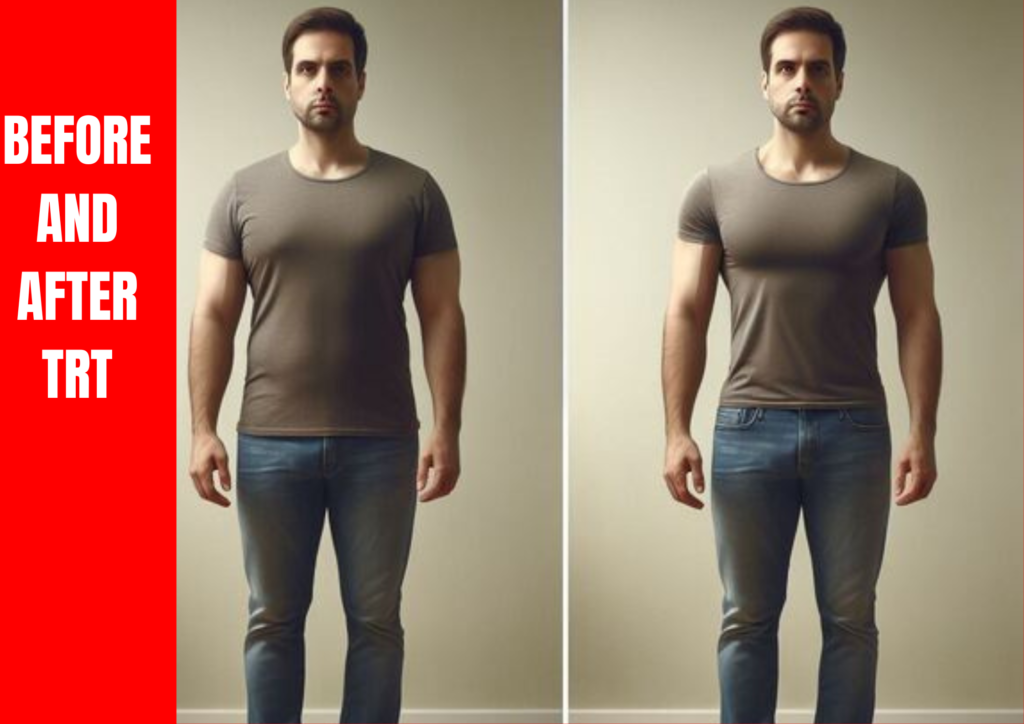
Considering TRT? What You Need to Know Before and After Starting
 In the realm of men’s health, testosterone is a cornerstone hormone that not only underpins physical attributes like muscle strength and body hair but also plays a crucial role in overall well-being, influencing everything from mood to energy levels. However, not every man’s body maintains optimal levels of this vital hormone throughout his life. Enter Testosterone Replacement Therapy (TRT), a medically supervised treatment designed to restore vitality in those experiencing the effects of low testosterone. If TRT is something you’re contemplating, there’s a lot to consider, from understanding the initial steps to managing ongoing treatment. Let’s dive deep into what you need to know before and after starting TRT.
In the realm of men’s health, testosterone is a cornerstone hormone that not only underpins physical attributes like muscle strength and body hair but also plays a crucial role in overall well-being, influencing everything from mood to energy levels. However, not every man’s body maintains optimal levels of this vital hormone throughout his life. Enter Testosterone Replacement Therapy (TRT), a medically supervised treatment designed to restore vitality in those experiencing the effects of low testosterone. If TRT is something you’re contemplating, there’s a lot to consider, from understanding the initial steps to managing ongoing treatment. Let’s dive deep into what you need to know before and after starting TRT.
The Prelude to TRT: Laying the Groundwork
Recognizing the Signs of Low Testosterone
The journey often begins with acknowledging the symptoms that might suggest low testosterone levels. These can range from the more well-known, like decreased libido and changes in sexual function, to less obvious signs such as fatigue, mood changes, and unexplained weight gain. Given these symptoms can overlap with other health conditions, it’s important not to jump to conclusions.
Seeking Professional Guidance
The critical first step on this journey is to seek advice from a healthcare professional. They can conduct the necessary blood tests to confirm if your testosterone levels are indeed below the norm. More importantly, they can help identify if there are underlying causes for your low testosterone that need to be addressed.
Understanding What TRT Can and Can’t Do
Before embarking on TRT, it’s vital to set realistic expectations. TRT can indeed lead to remarkable improvements in quality of life for many men, but it’s not a magic bullet nor a universal remedy. Discussing potential outcomes and limitations with your doctor can help align your expectations with reality.
The TRT Commitment: What Happens After Starting
Embarking on TRT is a commitment, not a one-off decision. Here’s what to anticipate once you start the therapy.
Monitoring and Maintenance
TRT requires ongoing management. Regular check-ups with your healthcare provider are essential to monitor your hormone levels and adjust the treatment as necessary. This ensures you’re receiving the optimal dose for your needs without veering into unsafe territory.
The Unfolding Improvements
The benefits of TRT won’t manifest overnight. Initial changes can take a few weeks to notice, with more significant effects, like improved muscle mass and reduced fat, potentially taking a few months. Patience is key—as is keeping your healthcare provider informed about your progress and any side effects.
Side Effects: Staying Vigilant
As with any treatment, TRT can have side effects, ranging from mild (such as oily skin or acne) to more serious (like an increased risk of blood clots). Being aware and proactive in discussing these with your doctor is crucial for managing them effectively.
Lifestyle: The Supporting Pillar
TRT is most effective when supported by a healthy lifestyle. Regular exercise, a balanced diet, adequate sleep, and stress management not only enhance the effects of TRT but also contribute to overall health and well-being.
Psychological and Emotional Dimensions
While TRT can positively affect mood and cognitive function, it’s important to monitor mental health closely. If you experience mood swings, aggression, or other significant changes, it’s important to discuss these with your healthcare provider.
Beyond TRT: The Larger Picture
The Role of Community and Support
Embarking on TRT can feel like a solitary journey, but it doesn’t have to be. Finding community either online or in-person can provide additional support and insight from those who’ve walked this path before you.
Continuing Education
Stay informed about the latest developments in TRT and men’s health. Understanding the evolving nature of treatments can help you make informed decisions about your care.
Advocating for Your Health
Finally, become an advocate for your health. This means not only adhering to the treatment plan and adopting a healthier lifestyle but also being proactive in your healthcare decisions, asking questions, and seeking second opinions if needed.
Conclusion
Testosterone Replacement Therapy represents a path to regained vitality for many men facing the challenges of low testosterone. However, it’s a journey that demands careful consideration, preparation, and commitment. By entering into TRT with a clear understanding of what to expect, what is expected of you, and the potential risks and benefits, you can make an informed decision that aligns with your health goals and lifestyle.
Remember, the most important aspects of this journey are the partnership with your healthcare provider and the commitment to yourself. TRT can be a powerful tool, but it’s most effective when combined with a holistic approach to health and well-being. Navigate this path with patience, perseverance, and an open line of communication with your medical team to optimize your therapy’s success and enhance your quality of life.
FAQs:
- Q: Will TRT Make Me Look Like a Bodybuilder?
- A: While TRT can help with muscle growth, it’s not a magic shortcut. Remember, the sculpted physiques you see often involve intense training, a dialed-in diet, and sometimes even additional supplements. TRT can give you that extra nudge to build muscle, but dedication is still key.
- Q: What About My Sex Life?
- A: This is a big one! Low testosterone can definitely dampen your libido. TRT can help in this area, but it’s not always a guaranteed fix. There could be other underlying issues at play. Talking openly with your partner and being patient with the process is important.
- Q: Is TRT Safe?
- A: Like any medication, TRT comes with potential side effects. That’s why getting monitored by a doctor is crucial. We’ll discuss these risks upfront and keep an eye out for things like increased red blood cell count or prostate changes.
- Q: Will TRT Affect My Fertility?
- A: Yes, TRT can impact sperm production. If you’re considering starting a family, discuss options for sperm banking with your doctor before starting therapy.
- Q: How Long Do I Have to Stay on TRT?
- A: Typically, TRT is a lifelong commitment. As you age, we may need to adjust the dosage to keep things optimized.
- Q: Is TRT Therapy Covered by Insurance?
- A: In some cases, yes! Insurance coverage for TRT can vary depending on your specific plan and provider. Here’s the key: You’ll need to demonstrate a documented need for testosterone replacement therapy. This typically involves having low testosterone levels confirmed by blood tests. It’s always best to contact your insurance provider directly to see what your specific plan covers for TRT.
- Q: TRT Replacement Therapy Cost?
- A: The cost of TRT can vary depending on several factors, including:
- The type of testosterone prescribed (gel, injection, patch)
- The dosage needed
- Your geographic location
- Whether you have insurance coverage
- A: The cost of TRT can vary depending on several factors, including:
Without insurance, the cost can range anywhere from $20 to $1,000 per month. If you have insurance and it covers TRT, you’ll likely pay a copay or coinsurance amount.
Remember, this is just a glimpse into the world of TRT. There’s a lot to consider, and every guy’s experience is unique. If you’re thinking about TRT, the most important step is to have an open and honest conversation with your doctor. They can help you weigh the pros and cons and create a personalized plan to get you back on track.
In the next post, we’ll dive deeper into the different methods for delivering TRT, from gels to injections. Stay tuned!
Table of Contents
SEARCH HERE
CATEGORIES
RECENT POSTS



Advanced Mitochondrial Formula 2025: Can It Truly Recharge Your Energy Levels?

The Truth About Aquaponics 4 You (2025): Does It Actually Work?




Hepato Burn Supplement Review: What You Need to Know Before Buying



“The Ultimate Guide to Papillex: Natural Immune Support for HPV Relief”



Slim Down Naturally: The Truth About Plant-Based Fat Burner That Actually Work

TedsWoodworking Review 2025: Is It Worth It for Your DIY Projects?




“Immunotherapy vs. Chemotherapy: A New Era in Cancer Treatment”





“The Ultimate Guide to Hyperpigmentation Laser Treatment in 2025”


Is UV 7 Good for Tanning? What You Need to Know Before You Glow


Planning a Trip from New Windsor to Grand Canyon? Here’s What to Know

